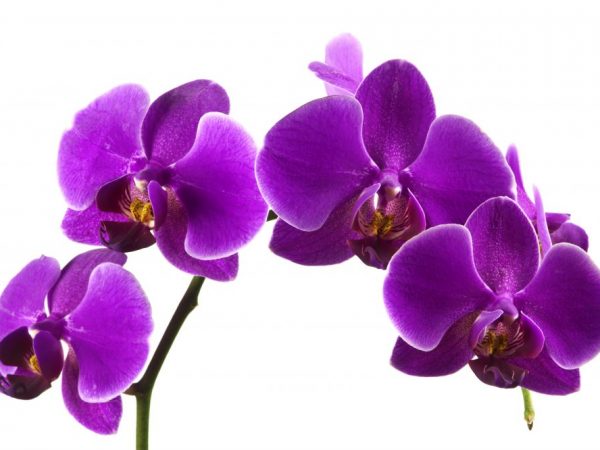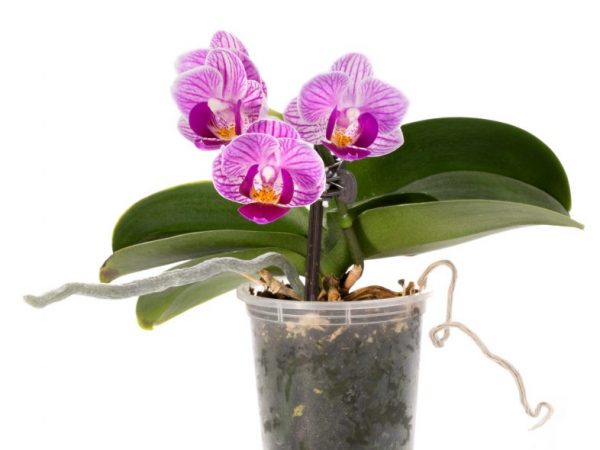Purple orchid care
There are types of orchids with the same morphological characteristics, but differing in flowers. The purple orchid is found in several varieties of this plant; flower care, depending on the species, has a lot of differences.

Purple orchid
Characteristics of the purple orchid
The purple orchid is one of the hybrid forms of the flower, due to which it adapts better to home conditions. The main feature of this species is purple flowers, the shade of which varies from light lilac to more intense. The plant is sometimes called the lilac orchid. There is another name for the flower, derived from the Latin, - Phalaenopsis violation.
Sometimes the orchid flower is artificially tinted by injecting special purple ink into the peduncle. Sometimes the paint is injected at the growth point, which is why the leaves are also stained.
Description of the species
This plant has a relatively hard peduncle - the shoot on which flowers are formed. It has a zigzag shape and is able to bend in different directions. Compared to other types of orchids, purple phalaenopsis has a small number of flowers. The flowering period lasts all year round. The largest number of them appears and lasts from spring to autumn.
Description of flowers
The flowers of this species have a pleasant, pronounced aroma, similar to the smell of bergamot or water lilies. Their maximum width is 6 cm. The petals are oblong, have an oval or oval-elliptical shape, a smooth surface, and a waxy appearance. Sometimes they have small, white-pink spots.
Leaf description
Phalaenopsis leaves are large, fleshy, have an oblong elliptical shape. The ends are either blunt or pointed. In an adult flower, the leaves grow up to 30 cm, their width is almost 15 cm.
Phalaenopsis purple varieties
Sometimes purple orchids thrive in the wild, but it is mostly a houseplant that belongs to the orchid family. There are several varieties of phalaenopsis that have purple flowers, but there are other varieties with flowers of similar hues, such as the pink orchid.
Wanda
The cultivar is capable of growing above 1 m. It has strong, drooping, gray-green roots that can absorb moisture from the air. Wanda is called bearded, because her huge root system is similar to a beard. For normal growth, the variety does not require soil: it grows well on the block.
The stems are cylindrical and have a large number of leaves. Usually, at least 4 peduncles grow on one plant, on average 15 large flowers with a pronounced aroma are formed on each of them.

Orchid Wanda
Phalaenopsis
The purple phalaenopsis orchid is one of the most common varieties. Its advantage is its ability to adapt to different climatic conditions, so it takes root well at home.Its name means "moth-like" because the flowers of this variety are similar to butterflies. They come in different shades, from lilac to deep purple. Sometimes there are white, white-purple and dark purple flowers. They have practically no aroma.
In the wild, Phalaenopsis purple grows on tree trunks, clinging to the bark with its roots. It has an air-root system, thanks to which it gets moisture from the air. Green roots are also involved in the process of photosynthesis. The leaves are collected in a rosette at the bottom of the stem. The flowering period reaches 6 months. Up to 100 flowers appear on one peduncle.
Dendrobium
This purple orchid variety is small in size. One of its features is the ability to shed leaves once a year. This orchid has epiphytic and lithophytic forms, but the former is more common. In the wild, it is a parasite, since it is attached by roots to the trunks and branches of trees and feeds on them.
Dendrobium has straight stems that transform into an arrow-shaped shape. The leaves in the lower part of the stem are not collected in a rosette, but grow throughout the shoot, including the upper part. They are dense, oval-elliptical in shape. There can be several peduncles, 4 flowers usually appear on each of them.
General purple orchid care
Violet orchid is sensitive to conditions of detention. Care for each variety of this type has its own characteristics. This is due to the fact that the characteristics of the varieties are different.
There are certain rules for caring for a plant, which are the same for all varieties. These include the choice of substrate and pot, ensuring the required air temperature and lighting, proper watering and feeding.
Substrate and pot
Purple orchids are famous for the fact that they do not need a potting mixture, therefore they use:
- tree bark (preferably pine or willow);
- moss;
- charcoal;
- pumice and expanded clay (for drainage).
Granite gravel or crushed bricks are also used as drainage. But they don't have to cover the entire bottom of the pot. Sphagnum is also placed there, which absorbs moisture well and gives it to the roots. If you add ground fern roots and peat to the substrate, you will not need to feed the flower.
The root system of this species is powerful, capable of growing strongly, so the pot is chosen large and stable. The plant should feel free in it. Plastic or ceramic containers are ideal for him, in which there should be holes to remove excess moisture.

Substrate and pot for purple orchid
Lighting and temperature
Purple orchid loves sunlight, but grows well and blooms in partial shade. Direct sunlight is bad for her condition. For good growth, it also requires an average of 13 hours of daylight hours, therefore, in winter, when the length of daylight hours decreases, additional lighting is artificially provided.
The suitable air temperature for phalaenopsis is from 15 ° C to 25 ° C. It grows poorly at hot temperatures. Gtami is best placed on the east or west side. The room where they are located must be periodically ventilated.
Watering and fertilizing
This species, like most others, loves humidity, the level of which should be at least 40%. If the air humidity is below this indicator, the leaves of the plant wither, flowers fall. Often watering and spraying the orchid is also not worth it: this leads to its rotting. It is better to water 1-2 times a week and only when the substrate is completely dry. Melted or rainwater should be used. If there is no way to get one, watering is carried out with boiled, settled water. When the stalks begin to dry out, they are cut off.
It is necessary to feed a purple orchid in a pot every month, no more than once. It is better to use fertilizers containing nitrogen, potassium and phosphorus. They are applied in the spring and summer at the doses indicated on the package.Too much fertilizer lowers the plant's immunity, which encourages infections. If you transplant phalaenopsis 2-3 times a year, the flower does not need feeding.
Features of care for each variety
The basic rules for care are the same for all varieties of purple orchids, but there are some nuances regarding the cultivation of each.
Caring for Wanda
The immunity of this variety directly depends on the temperature regime. The ideal air temperature for him is 25 ℃. A drop in temperature by 5 ℃ within a week provokes the appearance of diseases and causes stress in the flower. The humidity level should not fall below 60%. The plant is watered and sprayed with warm water in the morning.
Phalaenopsis care
Phalaenopsis is able to withstand 28 ° C, and will also develop normally at 17 ° C. For this flower, it is better to create a small shadow or diffused lighting: it does not react well to bright direct sun. It is watered every 1-1.5 weeks. Also, the room must be ventilated and monitored so that the humidity level is not lower than 40%.
Dendrobium care
Dendrobium grows well at 25 ° C. A significant decrease in temperature is not afraid of him: it retains its characteristics at 10 ° C. This is its main difference from other varieties. It is desirable that the temperature difference be kept within 5-7 ° C. Air humidity must be at least 60%. During the hot period, the flower is periodically sprayed. At the same time, it is imperative that moisture does not stagnate in the leaf axils.
This orchid variety does not tolerate drafts and direct sunlight. It is recommended to keep it together with the chitus, because in the wild, Dendrobium grows next to ferns, which serve as a support for its roots.
Transplant rules
Lilac phalaenopsis is transplanted only if absolutely necessary. If force majeure does not arise, the transplant is carried out every 3 years, since during this period the substrate loses useful substances. It is better to transplant in early spring before the active growth of the flower and the growth of the root mass.
If the plant has managed to release a flower arrow, it is not transplanted in order to avoid slowing down the development of the peduncle and dropping unopened buds.
As the plant grows and the roots grow, the pot is replaced with a larger one. The flower is moved into it by the rolling method. The process is carried out according to the algorithm:
- gently take the flower out of the pot, holding the roots;
- place the flower in a new container with a pre-prepared substrate;
- gently straighten the roots without compacting the substrate;
- insert a stick into the pot and fix the stem to it with a wire.
In the first month, fertilization should not be applied, since phalaenopsis will receive all the necessary nutrients from a new substrate. Watering is carried out 5 days after transplanting.
Conclusion
Caring for a lilac orchid is almost the same as for other types of this flower, but this plant has several varieties, so the rules for growing and caring are slightly different. Each variety has its own requirements, so before you start any varieties of purple phalaenopsis, you should carefully study the features of caring for them.


